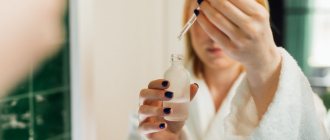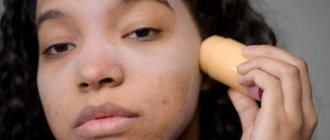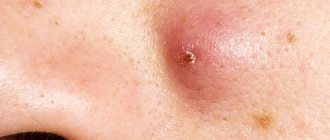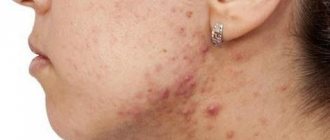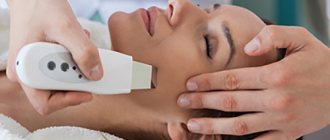The main causes of acne on the chin
In order to choose the right methods for correcting acne on the chin, we will determine the main causes of their occurrence:
- Rashes in the T-zone of the face (forehead, nose and chin) often appear due to increased sebum production. The sebaceous glands in these areas are most active, and the pores are enlarged. Excess sebum mixes with external impurities and accumulates in the pores, forming a sebaceous plug in which acne propionobacteria multiply.
- Hormonal imbalance in the body is another common cause of acne, including on the chin. Typically, acne associated with hormonal imbalance occurs during puberty in adolescents. Acne on the chin in women often breaks out during menstruation or pregnancy.
- Certain diseases can also affect the condition of the skin in this area, for example, dysfunction of the digestive system, spleen or kidney problems.
- Excessive sebum production in seborrheic areas is usually genetic and is caused by increased sensitivity of androgen receptors.
- Unsuitable skin type or insufficient care can often cause clogged pores and the appearance of acne on the face.
- Frequent stress, poor diet, and bad habits are also possible factors in the formation of rashes on the chin.
- Men have more sebaceous glands on their skin than women, and high levels of testosterone stimulate increased sebum synthesis. Also, in men, red pimples on the chin may break out after shaving.
Why should you see a doctor if you have cystic formations?
Treatment of severe acne can become more complicated due to the occurrence of acne elements of complex origin60:
- Phlegmonous. Confluences of large purplish-red pustules located in the deep layers of the dermis. They are characterized by a high rate of maturation and a tendency to form an abscess.
- Indurative. The result of the formation of a large infiltrate, which is located around the inflamed follicles. They have a bluish color. Such acne elements leave the most noticeable scars.
- Conglobate. Their appearance is also associated with the formation of infiltrate. Conglobate acne lies in the deep layers of the skin and is characterized by abscess formation. In addition to comedones, papules and pustules, many large nodes are formed; they are mainly located on the back and neck. The skin over them gradually becomes thinner, holes appear in it, from which pus comes out.
It is unrealistic to select effective drugs for therapy on your own. You should also be prepared for the fact that cystic acne can leave behind scars, which will have to be removed in a cosmetologist's office.
Classification of acne on the chin in dermatology
In dermatology, there are several types of rashes:
- Papules
are small subcutaneous tubercles without purulent contents. - Pustules
are classic pimples with purulent contents. - Comedones
(open and closed) - sebum accumulates in the ducts of the sebaceous glands and forms a subcutaneous white “head” or superficial blackheads. - Nodules
are hard, large and deep pimples, often accompanied by purulent discharge and painful sensations, indicating a strong inflammatory process and a high risk of scarring.
Depending on the age at which the rash appeared, acne is also divided into:
- children (allergic, inflammatory rashes);
- teenage (a lot of acne on the face due to hormonal changes in the body);
- acne in adulthood (acne on the face appears after 18 years);
- acne caused by external causes (for example, taking steroid or hormonal drugs).
Diagnostics
If signs of subcutaneous acne appear or if there are a large number of them, you should contact a dermatologist. The doctor will conduct an external examination and order laboratory tests of blood, urine and feces to determine the presence and type of infection or virus. A scraping may also be taken from the surface of the skin to identify the presence of subcutaneous mites.
Why can our articles be trusted?
We make health information clear, accessible and relevant.
- All articles are checked by practicing doctors.
- We take scientific literature and the latest research as a basis.
- We publish detailed articles that answer all questions.
To determine the cause of the appearance of purulent formations, consultation with other specialists is required, for example, a gastroenterologist, neurologist, endocrinologist.
After identifying the disease that caused acne, complex therapy is prescribed. First of all, it is necessary to eliminate the cause itself. After this, subcutaneous acne is treated.
How to properly care for skin prone to acne on the chin?
Increased sensitivity of the sebaceous glands or hormonal fluctuations are most often genetic in nature. Therefore, it will not be possible to radically change oily problem skin type to normal with the help of aesthetic procedures or home care, but it is possible to significantly improve its condition.
You can reduce shine, correct visible imperfections on the chin and prevent their reoccurrence with the help of a highly effective beauty routine for oily problem skin. Such products may include sebum-absorbing mattifying components, ingredients with soothing and skin-restoring effectiveness.
Rules for caring for oily problem skin:
- In the morning and evening, gently but thoroughly cleanse the skin of excess sebum and external impurities. As part of the cleanser formula, look for antibacterial (tea tree oil, AHA acids, piroctone, olamine) and moisturizing components, as well as keratolytics (hydroxy acids), which carefully remove dead cells of the stratum corneum. Use gentle cleansers, such as gels and foams, designed specifically for oily, problem skin.
- The next step is to use a lotion or tonic for oily skin prone to rashes and imperfections. Such products additionally remove residual impurities and cleansers from the skin, help tighten pores and prepare the skin for subsequent care.
- For deep cleansing and renewal of the skin, delicate exfoliants based on soft acids are suitable, which dissolve the stratum corneum of the epidermis without injuring it. Twice a week, apply mineral masks to problem areas to promote deep cleansing and reduce pores.
- For daytime care, a mattifying product with moisturizing properties is suitable; at night, apply soothing and intensively restoring formulas to the skin.
- Do not try to get rid of internal acne on the chin on your own - this will make the situation worse and can lead to scarring and new inflammation.
Prevention measures
To prevent acne from appearing not only on the chin, but also on other parts of the body, it is necessary to follow preventive measures. Experts advise adhering to the following rules:
- properly . You should limit the consumption of fatty foods, fast food, spicy, salty foods. It is also necessary to limit the amount of chocolate, cheese, alcohol, and carbonated drinks.
- Maintain your psycho-emotional state at the proper level. Stress, neuroses, depression and nervous tension negatively affect the state of health and skin.
- Wash your face daily with special products whose pH is no more than 4.5. To prevent acne, it is important to maintain hygiene, promptly wash off cosmetics and moisturize your facial skin.
- Use scrubs and peels. They remove the stratum corneum of the epidermis, preventing clogging of pores.
- Use high-quality cosmetics.
- Do not consume foods that cause allergic reactions.
- Regularly wipe your face with chamomile infusion.
Acne on the chin causes not only moral discomfort, but also pain. They often arise as a result of disruption of certain systems and organs. That is why they require diagnosis and treatment.
How to remove acne on the chin using salon procedures?
In addition to home corrective care for oily problem skin, you can contact a cosmetologist who will recommend aesthetic procedures appropriate for your type and condition of the epidermis, for example, cleansing to cleanse and reduce large pores or peelings that promote renewal, as well as even out the relief and tone of the epidermis.
Remember that salon care does not replace a basic home routine: daily self-cleansing, toning, moisturizing and mattifying will help maintain oily skin in between visits to the cosmetologist.
Can spots go away on their own?
How to quickly remove acne marks, and can they disappear without any help? This question is asked by many patients who are encountering this problem for the first time. It is important to remember that scarring and pigment formations on the skin cannot be ignored; it is imperative to undergo treatment. They do not go away on their own, and without the necessary therapy the situation can only get worse. Therefore, we recommend that you come for a consultation with a dermatologist and, if necessary, undergo an examination.
We recommend
Curacen Essence (20 fl x 2 ml)
Nanoneedles with ultra-thin walls 30G
Nanoneedles with ultra-thin walls 33G
Curacen – for injection
Review of La Roche-Posay products for skin prone to imperfections
If you have painful acne on your chin, corrective care for oily problem skin will help reduce visible imperfections. LRP products are highly effective, proven by independent studies. La Roche-Posay's Effaclar product formulas for oily problem skin contain active ingredients that contribute to a noticeable improvement in the condition of the epidermis and noticeable cleansing of the skin.
What products to choose for skin care prone to imperfections:
- If you have single imperfections, including those on the chin, try a topical product, for example, Effaclar AI Corrective Treatment for Oily Problem Skin The formula contains Niacinamide soothes the skin and prevents the development of imperfections, piroctone olamine is known for its antibacterial properties, lipo-hydroxy acid gently exfoliates , promoting the process of skin cell renewal.
- Effaclar Ultra micellar water for oily problem skin will help to gently cleanse your face without water and effectively remove makeup residues; it mattifies the skin well and visibly cleanses pores. For supporters of classic washing, Effaclar gel foaming gel with physiological pH and hypoallergenic non-comedogenic formula is suitable, delicately cleansing pores and removing excess sebum.
- After cleansing, wipe your face with a cotton pad moistened with a small amount of Effaclar Pore Tightening Lotion with a mattifying effect, which will help reduce facial oiliness and help even out skin tone and texture.
- Also suitable for caring for oily problem skin are products with antioxidants, epidermis-renewing AHA and BHA acids, niacinamide, piroctone-olamine and hydrofixing agents to prevent skin dehydration. Pay attention to the Corrective Emulsion for Oily Skin Effaclar K (+) or the Moisturizing Mattifying Emulsion Effaclar Mat. The product formulas not only help reduce facial shine, but also intensively moisturize oily skin, help strengthen the protective functions of the epidermis and prevent the appearance of new imperfections on the chin.
- Corrective cream-gel for problematic skin against imperfections and post-acne Effaclar DUO (+) with LHA acid, procerad and niacinamide will help to even out the tone and texture of the face, as well as smooth out stagnant spots after acne on the chin. The product stimulates cellular renewal of the epidermis, helps reduce post-acne, and moisturizes the skin well.
EFFACLAR AI
Local action corrective agent
Effectively affects imperfections and prevents the appearance of post-acne.
RUB 1,417 more details
EFFACLAR GEL
Cleansing foaming gel against acne
Cleanses the skin and pores of impurities, removes excess sebum.
951 rub. more details
EFFACLAR
Pore tightening lotion
Smoothes the skin surface, cleanses pores, mattifies.
RUB 1,468 more details
EFFACLAR MAT
Mattifying sebum-regulating emulsion
Eliminates oily shine, mattifies the skin for 6 hours, tightens pores.
RUB 1,618 more details
EFFACLAR DUO(+)
Corrective cream-gel
Instantly moisturizes and mattifies the skin, reduces imperfections and redness caused by them. After 8 days of regular use, the number of imperfections is noticeably reduced.
RUB 1,187 more details
Antibiotics for acne treatment –
Antibacterial drugs for the treatment of acne can be used both for external use (usually in the form of gels) and in the form of tablets for oral administration. Modern research shows that antibacterial therapy in patients with acne is not very effective, because Over time, it causes the formation of resistant strains of bacteria and, as a result, leads to more severe acne. But in some cases, antibiotic therapy for acne is still necessary, and in addition, there are ways to reduce the risk of bacterial resistance to antibiotics.
a) Mild to moderate papulopustular acne:
Antibiotics, if prescribed, are only externally. These may be drugs such as Dalacin, Clindovit or Clindatop. These drugs are monocomponent gels containing the antibiotic clindamycin. In addition, there are drugs in the form of solutions for topical use, for example, the drug Zerkalin. This drug is clindamycin based, but it also contains alcohol, which is actually not very good for acne patients (especially if you are also using retinoids and benzoyl peroxide).
Another drug - Zinerit (in the form of a solution that is applied using an applicator) - is based on erythromycin, but there are now many resistant strains of the bacterium P.acnes to this antibiotic. There are also combination preparations that, in addition to the antibiotic, may additionally contain either the retinoid adapalene or benzoyl peroxide. An example of several combination preparations in the form of gels:
- Klenzit-S – contains clindamycin 1% + adapalene 0.1%,
- Indoxyl – contains clindamycin 1% + benzoyl peroxide 5%.
Photos of some drugs –
Important: for papulopustular acne of mild or moderate severity, antibacterial gels are prescribed primarily only in cases where the predominant inflammatory elements in the patient are pustules with pus. In this case, in addition to the external antibiotic, we must simultaneously use + external retinoids, + benzoyl peroxide.
And here you may ask: why is it recommended to also use benzoyl peroxide when prescribing an antibiotic gel? Isn't one antibiotic enough? The fact is that the use of benzoyl peroxide together with an antibiotic greatly reduces the risk of P.acnes bacteria developing resistance to antibiotics. Including the development of such resistance contributes to the transformation of mild forms of acne into forms with a more severe course.
As for patients whose inflammatory elements are represented predominantly by papules (i.e., without pus), it is irrational to prescribe antibiotics in this case. It is optimal to use only a combination of external preparations “benzoyl peroxide + retinoid”.
b) Papulopustular form of severe acne:
For severe papulopustular acne, antibiotics are prescribed only orally (i.e. in tablets for oral administration), plus we prescribe externally retinoids + benzoyl peroxide. For systemic antibiotic therapy, drugs from the tetracycline group will be primarily used - this can be either tetracycline itself or its derivatives - doxycycline and minocycline. Only a doctor can determine the optimal dosage for each individual patient.
As for tetracycline, the average daily dosage is usually 1000 mg, but in serious cases the dose can be increased to 3500 mg per day (such doses can only be used under monitoring of liver function). Tetracycline can be taken only 1 hour before meals or 2 hours after; the duration of administration is determined by the doctor, but not more than 8 weeks. However, this drug has serious age restrictions, and in recent years more resistant strains of P. acnes have been discovered.
Much fewer resistant P. acnes strains have been found to lipophilic tetracyclines (such as doxycycline and minocycline). Doxycycline is taken at a dose of 100 to 200 mg per day orally for no more than 8 weeks, regardless of meals. However, it induces photosensitivity in the summer and therefore in summer it is better to use another antibiotic (azithromycin). Minocycline is also taken at a dose of 100-200 mg per day, but this drug can cause blue-black pigmentation in different areas of the skin. This pigmentation most often occurs in the area of atrophic scars and acne scars.
A good drug of doxycycline is
Antibiotics of the Macrolide group - previously a drug such as erythromycin was widely used, but now there are a lot of resistant strains of P.acnes to it. It is more preferable to prescribe azithromycin in a dose of 250 to 500 mg (taken only 3 times a week). Unfortunately, this drug may have side effects such as diarrhea, and therefore it is best to take it only with parallel medications to restore intestinal microflora. Azithromycin is a good alternative for patients who cannot use doxycycline.
Antibiotics of the Lincosamide group - clindamycin belongs to this group of antibiotics. But its use is justified only for external therapy (with the composition of products for external use), and when taken orally, there is too high a risk of getting a severe form of anibio-associated diarrhea, which is called pseudomembranous colitis. This is such a terrible thing (with a high mortality rate) that don’t even think about taking clindamycin tablets.
Drugs of the sulfone group - these include the drug Dapsone, but it can only be used if the patient develops resistance to other antibiotics (i.e. this drug will not be the first choice drug). Antibiotic resistance should be suspected if there is no response to treatment after 6 weeks of antibiotics. Moreover, in cases where we assume resistance, it is very important for us to exclude the development of gram-negative folliculitis in the patient (usually it occurs precisely after long-term use of antibiotics in the past).
Important: the most painful area of antibiotic therapy in the treatment of acne is the development of resistant strains of P.acnes and S.epidermidis. Concurrent use of topical benzoyl peroxide products with antibiotics, and avoidance of frequent changes between different antibiotics, are the best ways to prevent antibiotic resistance in P. acnes and S. epidermidis. Phototherapy procedures (IPL), photodynamic therapy, and the use of lasers can help reduce the need for antibiotics. We will tell you more about them at the end of the article.
Mistakes in caring for oily skin that can cause acne on the chin
Here are the most common mistakes that people with problem skin types make:
- The desire to get rid of excessive oiliness and small pimples on the face by intensive cleansing or squeaky cleansing can negatively affect the condition of the problematic epidermis: the natural hydrolipidic barrier of the skin is disrupted, dryness, dehydration, peeling and irritation appear. At the same time, sebum production increases, which in turn contributes to the emergence of new rashes.
- The use of nourishing and thick creams in the beauty routine, which create a thick, oily film on the surface of the epidermis, can further clog the pores and provoke new rashes on the chin. Such products are more suitable for dry or normal skin types. Non-comedogenic formulas are suitable for caring for oily skin.
- Using formulas with a high alcohol content will also not solve the problem of oiliness or get rid of breakouts. Alcohol can dehydrate the skin; this ingredient, of course, does not have a soothing or restorative effect. Instead, include products based on AHA and BHA acids, such as salicylic or glycolic acids, into your beauty routine, which additionally have a noticeable exfoliating effect and promote skin cell renewal.
- Insufficient hydration is another possible cause of facial rashes. Dehydrated, oily skin reacts by increasing the synthesis of sebum in order to self-hydrate. Choose formulas based on mattifying and moisturizing ingredients that prevent dehydration and at the same time reduce facial oiliness.
What are cysts?
A cyst is a pathological cavity in the tissues, which has dense walls and thick contents. The fusion of cysts and penetration into foci of infection leads to compaction of the formations, and sometimes to infiltration and abscess formation.
With cystic acne, areas of severe inflammation form. The cysts fill with pus, and pressing on them causes pain. Cystic elements are easily squeezed out, but this should not be done, as this can lead to tissue scarring.
Nodular cystic acne refers to a severe form of acne. Most often this happens if the disease is advanced and there was no timely treatment. The chronic inflammatory process provokes the formation of nodules with a diameter of more than 1 cm, which merge with cysts and other types of rash. In this case, the disease affects the deep layers of the dermis.
How to prevent the formation of new acne in the chin area?
To prevent acne on the chin, follow the recommendations of Alexander Prokofiev, a dermatologist and medical expert of the La Roche-Posay brand:
- Don't forget about moisturizing oily problem skin: lack of moisture in cells causes dehydration, which provokes increased sebum production and excessive shine in the T-zone.
- If there are a lot of painful acne on your face, be careful when choosing decorative cosmetics - choose formulas that do not clog pores. Try an imperfection-concealing product for oily problem skin with a non-comedogenic composition and a light degree of concealment, for example, Effaclar Duo(+) Unifant Corrective Cream-Gel, which well evens out the tone and texture of the face without clogging the pores.
- Cleanse your face twice a day using gel cleanser or micellar water for oily skin if you prefer waterless cleansing. Deep cleanse your skin twice a week, use gentle scrubs, peels and clay masks.
- Choose care with antibacterial, soothing, mattifying properties and formulas based on zinc, niacinamide, acids (AHA, linoleic, salicylic, hydroacids), niacinamide, piroctone-olamine, antioxidants, probiotics.
How to treat acne with a cosmetologist: types of professional cleanings
Facial cleansing is not a daily procedure. It should be performed by an experienced cosmetologist. The following types of procedure exist:
- Mechanical or manual. It is carried out with your fingers, a special tool (uno spoon) or a vacuum device after preliminary steaming of the face. If you have red pimples* (papules) or rosacea, it is better to avoid manual cleansing in favor of acid peeling, since the likelihood of re-infection is very high, and steaming the inflamed skin can aggravate the problem of painful acne*.
- Chemical. It is carried out using various exfoliating substances, such as fruit acids (lactic, tartaric, glycolic, citric, malic, salicylic, azelaic, etc.). This is a fairly gentle treatment, suitable for sensitive skin with acne. While cleansing the epidermis, it also has an anti-inflammatory effect;
- Iontophoresis. With the help of galvanic current, beneficial substances are transported into the upper and middle layers of the dermis for therapeutic purposes, which narrow dilated capillaries, helping to remove comedones and improve tone.
- Cavitation peeling. Carried out using ultrasound. Deeply cleanses pores, which promotes the penetration of nutrients into the epidermis and improves oxygenation. Cavitation exfoliates dead skin particles and has a rejuvenating effect.
The cosmetologist should select the procedure. It is not performed in the presence of inflammatory elements.

